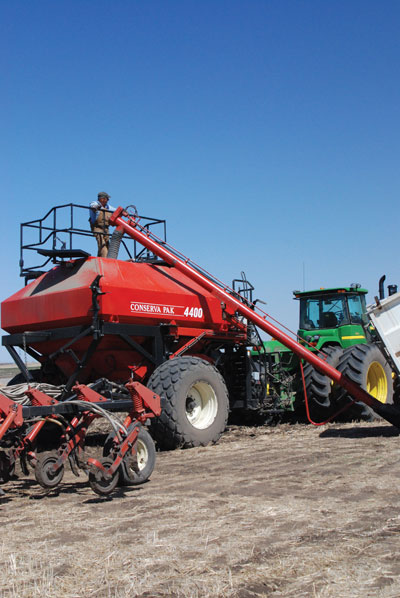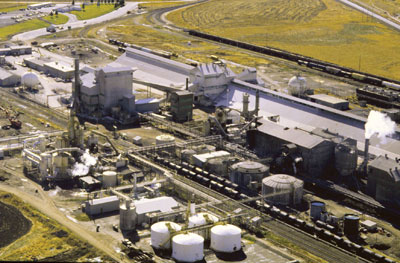
Features
Inoculants
Seed & Chemical
Is it safe to cut back on phosphate?
High phosphate prices are raising questions on whether this might be the time to cut back or eliminate P fertilizer even if it means accepting a slight yield drop
February 24, 2009 By Helen McMenamin
*Editor’s Note: At the time of printing, prices on phosphate fertilizer had fallen from their highest levels during the autumn of 2008. Although prices are considerably lower, the fluctuations from week to week still warrant many of the recommendations cited in this story. As always, Top Crop Manager recommends consulting an agronomist or inputs dealer for additional information. RP
High phosphate prices are raising questions on whether this might be the time to cut back or eliminate P fertilizer even if it means accepting a slight yield drop. According to soil fertility experts, the answer is ‘maybe.’ “If you’ve had a good nutrient program, you can probably cut back P in the short term,” says Tom Jensen, of the International Plant Nutrition Institute. “For well-fertilized fields, you may be able to cut back by a third to a half. But, that’s not a blanket recommendation. Cutting back on P on land that hasn’t been fertilized as well, or on sandy land that can’t hold the same level of nutrients, may lower yields quite drastically. Focus on the individual needs of each field.”
 |
|
| Cutting fertilizer under certain circumstances might be a good risk management strategy. Photo courtesy of Bruce Barker. |
University of Manitoba soil fertility specialist Don Flaten suggests that when phosphate prices are high relative to grain prices, a grower might be able to withdraw some of the phosphate reserves he has built up in his soil. But he cautions that, as with any savings account, this is not something that can be done indefinitely.
Alberta Agriculture Agronomy Research Scientist Ross McKenzie offers some numbers to guide any cutbacks. He has studied crop responses to fertilizer P at more than 500 sites across Alberta. “If your soil tests for a particular field show adequate soil P levels, above 50 lbs/ac in the zero to six inch depth, you probably won’t see much loss in yield of cereal and oilseed crops from seeding without P fertilizer,” he says. “Starter fertilizer does give a pop-up effect that’s quite obvious, especially when soil is cooler than normal. But after the first few weeks, crops seeded without P fertilizer often catch up and in the end yield about the same as P-fertilized crops. We’ve seen this in wheat, barley, canola and peas.”
For peas, McKenzie has not seen yield benefits from P fertilizer as long as the soil P is 30 lbs/acre or more. But for cereals and oilseeds on fields with 30 to 50 lbs/ac P in the soil, he advises up to 20 lbs/ac of starter P.
For fields with low available soil P, less than 30 lbs/ac in the zero to six inch depth, McKenzie advises applying the amount recommended for a target yield. Most crops respond to fertilizer P when soils test low in P. “Look for a fertilizer response that returns $2 for every dollar you invest in P,” he says. “You might gain a couple of bushels in yield from applying starter P, but even for canola, at $10, with today’s P price, it’s cost you $22 to make $20.”
Look for alternative sources of P
Manure or compost, with its high phosphate content, is an excellent alternative to commercial fertilizer, says McKenzie. The conventional notion that hauling manure more than 20 miles is cost prohibitive, was based on the prices prevailing some time ago. That advice held as long as fuel and fertilizer prices rose in step. Now, fertilizer prices have risen faster than fuel costs. It may well be worth hauling manure further than was reasonable a few years ago. A grower can haul compost even further and still be ahead.
When applying manure or compost, McKenzie advises calculating application rates to meet crops’ P needs for four years; that is generally in the range of 100 to 150 lbs/ac, based on each bushel of grain removing 0.6 lbs (P2O5). Applying manure or compost to provide that rate to a quarter of one’s cropland each year should allow a grower to continue cropping without applying granular P fertilizer or losing yield due to P deficiency.
 |
|
| Agrium’s Conda Phosphate Operations, Conda, Idaho. Photo courtesy of Agrium Inc. |
Flaten agrees with that approach, and believes the agricultural industry needs to go further in using alternative sources of P. “We can replace some of the P we export from the farm by recycling some of the P that remains in agriculture, by applying manure and taking advantage of animal urine,” he says. “But we export most of our crop nutrients as grain or other products to the cities and they’re lost to agriculture. We really need to recycle the phosphate that’s exported to the cities and flushed down the toilets. We have finite supplies of phosphate in the world and we may already be past peak production. The technology is available to reclaim phosphate from sewage. We need to use it.”
Flaten is describing precipitation of struvite (ammonium magnesium phosphate) from municipal wastewater at Edmonton’s Gold Bar Wastewater Treatment Plant, which has used the technology since spring 2007. The plant handles wastewater from a city of 750,000 people and produces about 500 kg of struvite per day, removing more than 80 percent of P that might otherwise contribute to pollution of rivers and lakes as well as causing scaling problems in the treatment plant and pipelines. The technology, which the plant manager says is “so simple we haven’t been able to break it,” is being installed in other wastewater and ethanol plants.